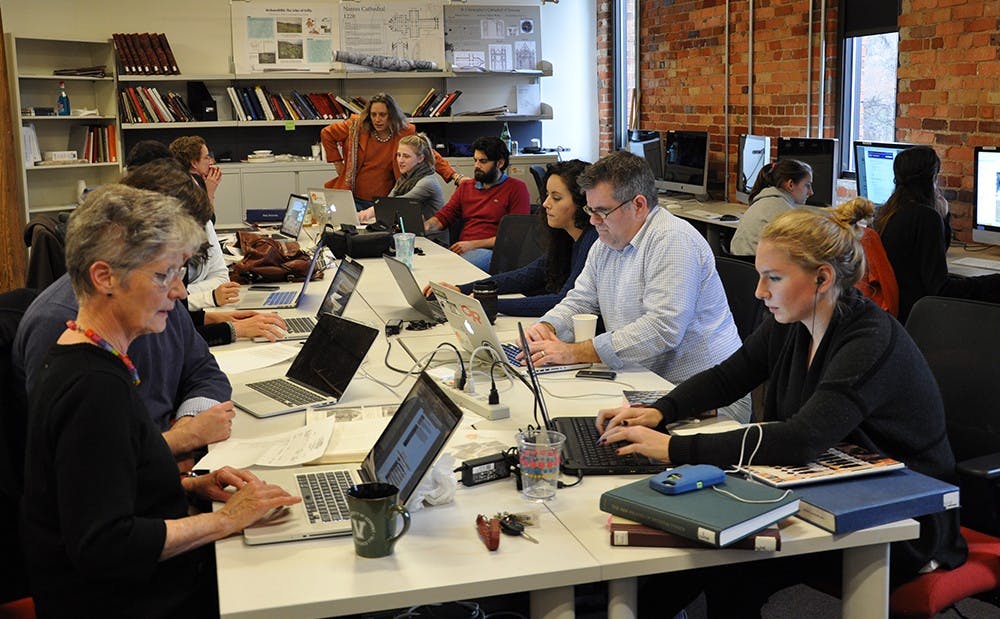Faculty and students from many disciplines at Duke are searching for connections between what is old in art and what is new in technology.
The Duke Wired! group will examine the intersection of modern technology and the artistic humanities in its “Apps, Maps & Models: Digital Pedagogy and Research in Art History, Archaeology and Visual Studies” symposium Feb. 22. The free, one-day symposium features distinguished professors from across the country speaking on topics as diverse as “mapping architecture in 1914 - 1924 Germany” to “Italian Renaissance Piazza as a social media space.”
Wired! is composed of faculty, staff and undergraduate and graduate students and applies the study of culture, art, architecture and urban history. The symposium itself marks significant strides in the group’s efforts to engage more of the community in the digital humanities.
“As our group has grown and evolved, with numerous teaching and research initiatives, we thought it was time to evaluate our initial vision to understand how our work relates to that of the broader emerging disciplines in digital humanities and digital art history,” Caroline Bruzelius, Anne M. Cogan Professor of Art, Art History and Visual Studies, and John Taormina, director of the Visual Media Center, wrote jointly in an email.
Wired! originally consisted of a small but diverse group—a classical archaeologist, a visual artist, an art historian, a media studies specialist and a computer scientist. Their original goal of exploring digital visualization technologies for art, architecture and urban space expanded into courses for students of all levels, multiple research projects at the Wired! Lab and other teaching and research initiatives. In 2014, Wired! introduced a degree in Historical and Cultural Visualization.
The Wired! group has also organized an impressive group of speakers from Duke and outside institutions for the symposium, each working on unique projects.
“We looked for really interesting projects that involve a wide range of digital tools (3D modeling, ArcGis, mapping tools, databases, interactive museum displays, apps, etc.) from ancient to modern art and architecture, including both western and non-western topics,” Bruzelius and Taormina wrote.
Several of Wired!’s past projects have also incorporated such tools. One project, “Old Stones, New Technologies,” was headed by Bruzelius and professor of computer science Carlo Tomasi and tested a data capture system to study medieval construction and labor. Through the system, students studied historical buildings using data mining, texture analysis and pattern recognition.
The team of the Wired! group’s ongoing “Digital Athens” project is producing a database and digital map of archaeological remains of ancient Athens. The digitization and visualization are based on data from historical maps and material collected from the Athens Metro Excavations.
Digital technology is now permeating almost every aspect of material culture. While materials such as art pieces and architecture reveal thousands of stories about civilizations and history, Bruzelius and Taormina drew attention to the gap between these unheard stories and the modern museum visitor. In Fall 2014, “Digital Athens” received a grant from the Josiah Charles Trent Memorial Foundation Endowment Fund to cover expenses for an undergraduate to work on the project in Athens and encounter archaeological remains.
“Big data—archaeological data, or the history of the art market, or the commodification of raw materials of works of art—can really change the way we understand the production and dispersion of artworks,” Bruzelius and Taormina added. “Digital tools now allow us to gather, collate and interrogate this information in different, and more efficient, ways.”
The significance of museums in these digital humanities developments is significant, as museum works constantly interact with an audience. Interactive displays, for example, allow all people rather than just experts to be engaged and knowledgeable about the subjects.
“With digital interactive displays we can explain the origins or context of a work of art in terrifically exciting ways that reach out to the public to greatly enhance their experience,” Bruzelius and Taormina said.
The Nasher Museum of Art’s “The Lives of Things” project, for example, engages visitors with the idea that ancient and medieval art was always brightly painted. The project consists of recreating the coloring of four Brummer Apostles statues with computer-aided design software to help viewers better undewrstand the original context for the reliefs.
Ultimately, digital technology maintains a significant stake in how people experience the physical world and art. The research projects spearheaded by faculty, graduate, and undergraduate students and the projects on which symposium speakers will present serve as specific answers to the myriad of opportunities that the digital humanities open.
“Digital tools represent a miraculous development for telling the stories of art, architecture and cities,” Bruzelius and Taormina wrote.
Get The Chronicle straight to your inbox
Signup for our weekly newsletter. Cancel at any time.

